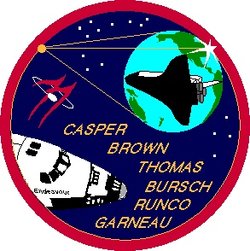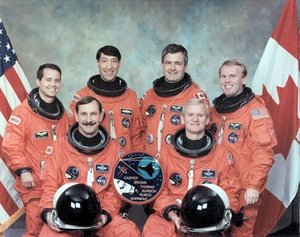STS-77
|
|
STS-77 is a Space Shuttle program mission.
| Space Shuttle program | |
|---|---|
| Mission Insignia | |

| |
| Mission Statistics | |
| Mission: | STS-77 |
| Shuttle: | Endeavour |
| Launch Pad: | 39-B |
| Launch: | Sunday, May 19, 1996 at 6:30:00.066 am EDT |
| Landing: | KSC May 29, 1996 at 7:09:18 am EDT Shuttle Landing Facility Runway 33. |
| Duration: | 10 days, 0 hours, 40 minutes, 10 seconds. |
| Orbit Altitude: | 153 nautical miles (283 km) |
| Orbit Inclination: | 39 degrees |
| Distance Traveled: | 4.1 million miles (6.6 million km) |
| Crew photo | |

| |
| Previous Mission: STS-76 |
Next Mission: STS-78 |
| Contents |
Crew
- John H. Casper (4), Commander
- Curtis L. Brown Jr. (3), Pilot
- Daniel W. Bursch (3), Mission specialist
- Mario Runco, Jr.(3), Mission Specialist
- Marc Garneau (2), Mission Specialist (CSA)
- Andrew S. W. Thomas (1), Mission Specialist
Mission Parameters
- Mass:
- Orbiter Liftoff: 115,456 kg
- Orbiter Landing: 92,701 kg
- Payload: 12,233 kg
- Perigee: 278 km
- Apogee: 287 km
- Inclination: 39.0°
- Period: 90.1 min
Mission Highlights
NASA's flight of shuttle Endeavour is devoted to opening the commercial space frontier. During the flight the crew will perform microgravity research aboard the commercially owned and operated SPACEHAB module. The mission will also deploy and retrieve the Spartan-207/IAE (Inflatable Antenna Experiment) satellite and will also rendezvous with a test satellite. A suite of four technology experiments known as the Technology Experiments for Advancing Missions in Space (TEAMS) will also fly in the Shuttle's payload bay.
The SPACEHAB single module will be carrying nearly 3,000 pounds (1,400 kg) of experiments and support equipment for 12 commercial space product development payloads in the areas of biotechnology, electronic materials, polymers and agriculture as well as several experiments for other NASA payload organizations. One of these, the Commercial Float Zone Facility (CFZF) has been developed through international collaboration between the U.S., Canada and Germany. It will heat various samples of electronic and semiconductor material thru the float zone technique. Another facility on SPACEHAB will be the Space Experiment Facility (SEF) which will grow crystals by vapor diffusion.
The Goddard Space Flight Center. s (GSFC) Spartan-207 satellite will be used to deploy and test the Inflatable Antenna Experiment (IAE) which will lay the groundwork for future technology development in inflatable space structures. It will test the performance of a large inflatable antenna during a ninety-minute mission. The antenna structure will then be jettisoned and the SPARTAN-207 spacecraft recovered at mission end.
Inside Endeavour's cargo bay the four TEAMS experiments will operate throughout the mission. They include the Global Positioning System (GPS) Attitude and Navigation Experiment (GANE) which will determine to what accuracy the GPS system can supply attitude information to a space vehicle; the Vented Tank Resupply Experiment (VTRE) will test improved methods for in-space refueling; the Liquid Metal Thermal Experiment (LMTE) will evaluate the performance of liquid metal heat pipes in microgravity conditions and the Passive Aerodynamically Stabilized Magnetically Damped Satellite (PAMS) payload will be a technology demonstration of the principle of aerodynamic stabilization in the upper atmosphere. Cameras on the shuttle will record the PAMS satellite as it is deployed and track its movements.
Secondary experiments on the flight will include the Brilliant Eyes Ten Kelvin Sorption Cryocooler Experiment (BETSCE), the Aquatic Research Facility (ARF) and the Biological Research In a Canister (BRIC) experiment.
Related articles
- Space science
- Space shuttle
- List of space shuttle missions
- List of human spaceflights chronologically
External links
- NASA mission summary (http://science.ksc.nasa.gov/shuttle/missions/sts-77/mission-sts-77.html)
| Previous Mission: STS-76 |
Space Shuttle program | Next Mission: STS-78 |
